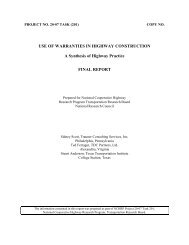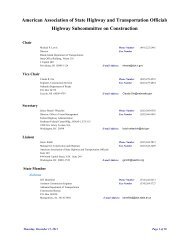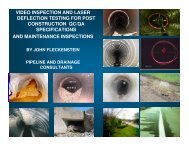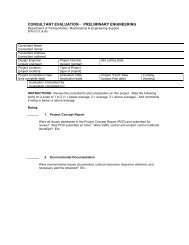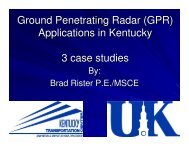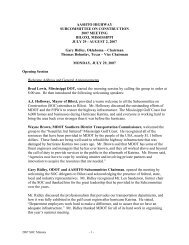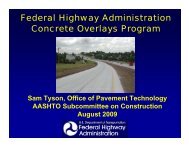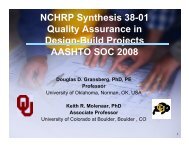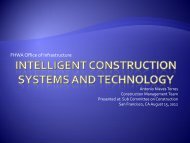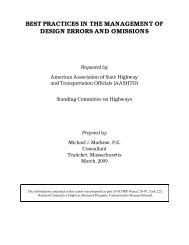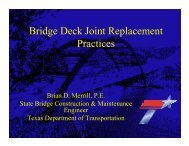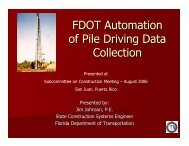I-35W Bridge Collapse Investigation I-35W Bridge Collapse ...
I-35W Bridge Collapse Investigation I-35W Bridge Collapse ...
I-35W Bridge Collapse Investigation I-35W Bridge Collapse ...
You also want an ePaper? Increase the reach of your titles
YUMPU automatically turns print PDFs into web optimized ePapers that Google loves.
I-<strong>35W</strong> <strong>Bridge</strong> <strong>Collapse</strong><br />
<strong>Investigation</strong><br />
Tom Everett, P.E.<br />
Principal <strong>Bridge</strong> Engineer<br />
FHWA Office of <strong>Bridge</strong> Technology
FHWA Role<br />
•<strong>Investigation</strong><br />
•Testing<br />
•Analysis
DOT Secretary Mary Peters offered…<br />
August 2<br />
• Full financial and technical support<br />
• Administrator Rick Capka to stay in MN<br />
• <strong>Bridge</strong> and Engineering Staff<br />
• Initial Distribution of $5.0M<br />
– restore traffic<br />
– clear debris<br />
– set up detours<br />
– begin repair work
Failure <strong>Investigation</strong><br />
August 2<br />
• NTSB requested FHWA’s help:<br />
– Drs. Joey Hartmann & Bill Wright<br />
• FHWA Roles:<br />
– Provide engineering expertise<br />
– Assist in field investigation<br />
– Assist in recovery operations<br />
– Analyze structures, fracture surfaces and<br />
failure mechanism
I-<strong>35W</strong> <strong>Investigation</strong><br />
• NTSB has lead and controlling role<br />
• FHWA was leveraged by NTSB for bridge<br />
expertise<br />
• Mn/DOT has engaged WJE to perform an<br />
independent investigation<br />
• 3 times lucky!
U-10<br />
L 11
Lucky #1
Technical Advisory 5140.27<br />
August 2, 2007<br />
• Strongly advise immediate re-inspection of all<br />
fracture critical deck truss bridges.<br />
• At a minimum, owners should review<br />
inspection reports to determine if more<br />
detailed inspections are warranted.
Lucky #2
Technical Advisory 5140.28<br />
August 8, 2007<br />
• Construction loads were present on I-<strong>35W</strong> I<br />
but<br />
the significance of these loads is not yet known.<br />
• Strongly advise that bridge owners who are<br />
engaged in or contemplating any construction<br />
operation ensure that any construction loading<br />
does not overload bridge members.
“Adequacy of the U10 & L11 Gusset Plate<br />
Designs for the Minnesota <strong>Bridge</strong> No.<br />
9340”<br />
• Holt and Hartmann<br />
• “Forensic” design of primary truss gusset plates<br />
• Not intended to provide a procedure for rating<br />
(Guidance from Dr. Ibrahim at HIBT)
Division I of the A.A.S.H.O. “Standard<br />
Specification for Highway <strong>Bridge</strong>s”, 1961<br />
Ed. (1961 & 1962 Interims)<br />
• Gusset plates shall be of ample thickness to<br />
resist shear, direct stress, and flexure, acting<br />
on the weakest or critical section of maximum<br />
stress.<br />
• If the length of an unsupported edge …<br />
exceeds 48 times its thickness, the edge shall<br />
be stiffened.
U10 Gusset Design Checks
Technical Advisory 5140.29<br />
January 15, 2008<br />
• Load ratings required according to the AASHTO Manual<br />
for Condition Evaluation of <strong>Bridge</strong>s. The following<br />
supplemental actions are recommended:<br />
– New or replaced truss bridges – check gusset plate<br />
capacity as part of the initial load rating.<br />
– Existing truss bridges – check gusset plate capacity<br />
when load rating after condition or load changes of the<br />
structure.<br />
– Review previous load rating calculations for truss<br />
bridges that have undergone significant changes is<br />
stress levels previously in their service life.
Recovery, Assessment and Evaluation
Recovery
Assessment
Evaluation
• Tension Testing<br />
Material Properties Testing<br />
– Modulus<br />
– Yield Strength<br />
– Ultimate Strength<br />
– Strain Capacity<br />
• Charpy Testing<br />
– CVN Energy<br />
• Compact Tension<br />
Testing<br />
– Fracture Toughness
Lucky #3<br />
72”<br />
½” thick<br />
U10W<br />
U10E
Amplitude of<br />
“buckle”<br />
estimated<br />
at 0.70”+/-<br />
0.15”
Wet Concrete<br />
Deck and Barriers<br />
New Deck and Barriers<br />
Construction/Traffic
Steel & Wet<br />
Concrete<br />
Deck and<br />
Barriers<br />
New Deck<br />
and Barriers<br />
Construction &<br />
Traffic<br />
Failure
Significant Causal Factor…DESIGN ERROR<br />
• Design did not meet strength limit state<br />
and was not detailed properly for stability.<br />
• Construction loading<br />
• Deformed (‘buckled(<br />
buckled’) ) gusset plate
Non-factors (NTSB to date)<br />
• Material<br />
• Deterioration…maintenance, aging<br />
infrastructure<br />
• Fatigue<br />
• Traditional Rating<br />
• Inspection
• Ohio bridges<br />
Isolated Incident<br />
• Additional Minnesota bridges
Questions



